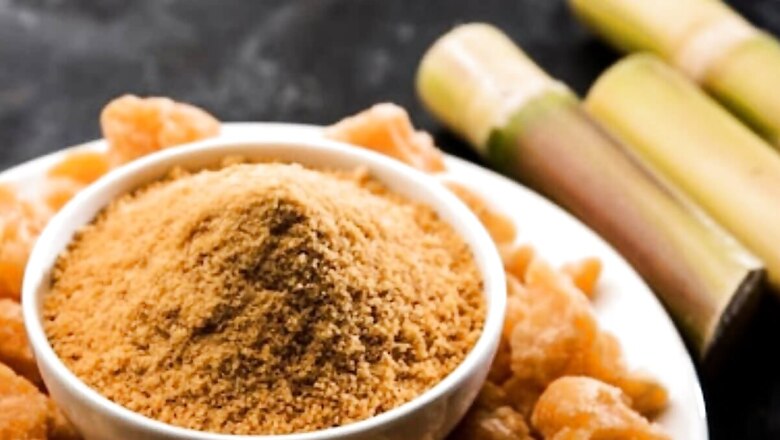
views
Jaggery has been used in India since Vedic times. The oldest Ayurvedic health treatise, the Charaka Samhita, states that jaggery “produces abundant marrow, blood and muscle.” This natural sweetener is used across the country in various sweet and savoury dishes and is also becoming increasingly popular in the Western world. Here are the different types of jaggery.
Cane Jaggery
The most popular jaggery in Indian cuisine is made from sugarcane. Jaggery is made by crushing the sugarcane to extract the juice, filtering and boiling the concentrated juice, and then freezing and hardening the liquid to obtain jaggery blocks. It is most commonly consumed in crystallized form. Due to the juice extracted, sugarcane jaggery has a sweet flavour with a hint of salt.
Coconut Jaggery
Unfermented coconut juice is used to make coconut jaggery, which is then drained, heated, crystallized and filled into different shapes. Due to the freezing effect of the environment, this semi-solid jaggery gradually turns into a crystallized, hard mass. Coconut jaggery and coconut jaggery powder are more commonly consumed by many people than sugarcane jaggery. It is one of the different types of jaggery commonly used in South Indian cuisine.
Palm Jaggery
The taste of palm jaggery, also called Khajoor Gur, is somewhat comparable to that of chocolate. Compared to refined sugar, palm jaggery retains all its nutrients even after processing. It is rich in minerals like potassium, phosphorus, magnesium and iron. The juice of the date palm is extracted, boiled and hand-pressed to make this jaggery.
Marayoor Jaggery
Originating from Marayoor town in the Idukki district of Kerala, Marayoor Jaggery is the result of sugarcane cultivation by farmers from the Muthuva tribe. Due to its distinctive taste and health benefits, this variety of jaggery is widely consumed in South India.
Palmyra Jaggery
Palmyra Jaggery, also known as Palm Jaggery or Taal Jaggery, is extracted from the sap of the Palmyra palm tree. Its creamy white to yellowish colour sets it apart and makes it a popular part of the culinary traditions of West Bengal.
Toddy Palm Jaggery
A speciality of Myanmar, Toddy Palm Jaggery is made by boiling the sap of the Toddy palm tree. With its rich aroma and golden brown colour, this variety of jaggery is very popular for its unique taste and potential health benefits.
Benefits of Jaggery
- Boosts energy levels:
Jaggery provides progressive energy that lasts longer than sugar, which only provides a temporary energy boost. The reason is that jaggery is unprocessed, so it does not alter blood sugar levels immediately but increases gradually. This, in turn, can help prevent fatigue.
- Relieves menstrual cramps:
An all-natural remedy for pain during menstrual cramps is jaggery. Endorphins, a pleasant hormone released when jaggery is consumed, help reduce PMS symptoms like mood swings, impatience, cravings, and more. Regular consumption of jaggery can also help control irregular menstrual cycles.
- Controls blood pressure:
The potassium and sodium content of jaggery helps maintain the acid balance of the body. This, in turn, keeps blood pressure within an acceptable range. The dilation of blood vessels caused by jaggery stabilizes blood pressure and allows for smooth blood flow.
- Detoxifies the liver:
Jaggery is a natural cleanser that is particularly good for the liver. The natural sweetener helps in eliminating dangerous toxins from the body. This further promotes liver detoxification. Therefore, consumption of jaggery is recommended for people suffering from liver diseases.


















Comments
0 comment